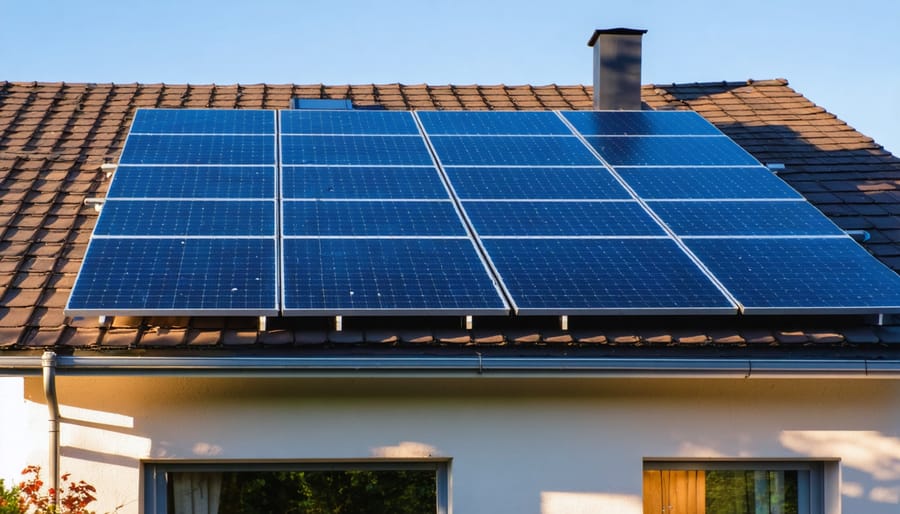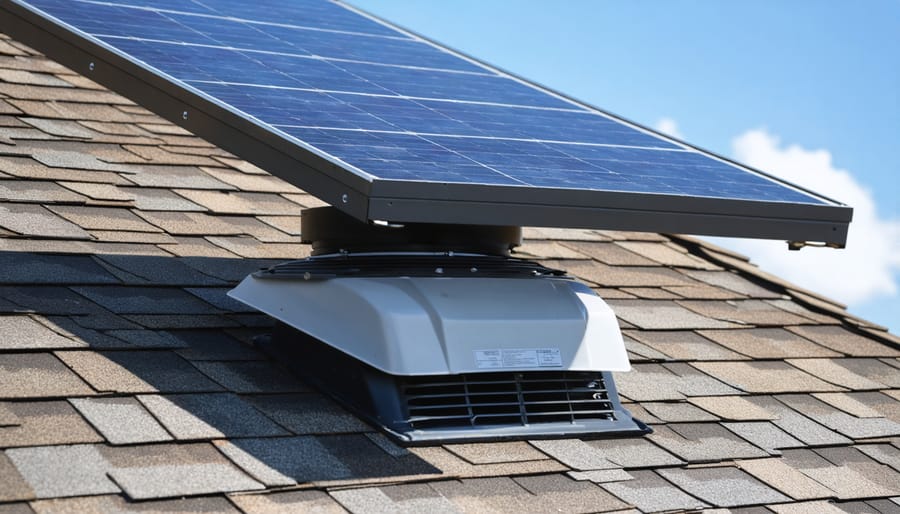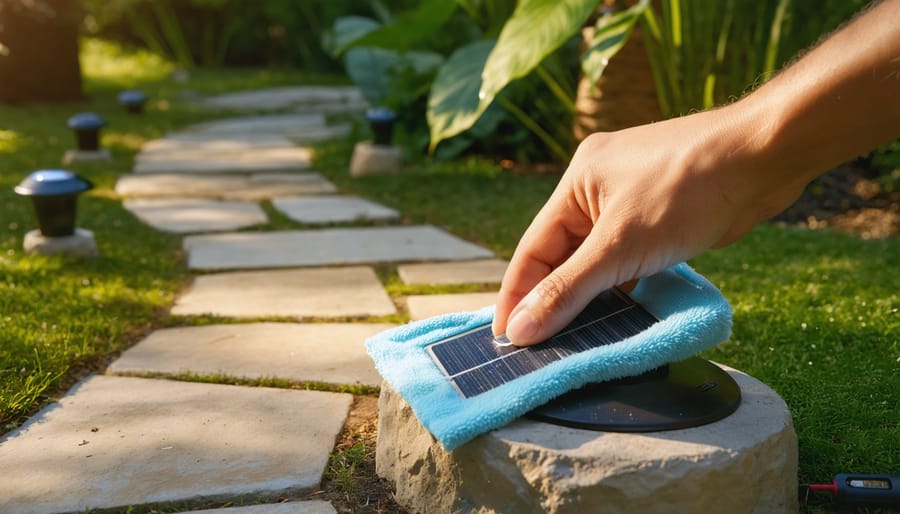Should You Use a Separate Pump for Solar Pool Heater?
Updated:

Using a separate pump specifically for your solar pool heater is more beneficial than relying on your main pool filter pump. A dedicated solar pump optimizes flow rate, maximizes efficiency, extends equipment life, and reduces operating costs.
This article will explain the pros and cons of adding a separate solar pump versus tapping into your existing pump. I’ll also cover the various ways to configure the pumps and plumbing based on factors like whether you have existing solar ports and want a completely isolated loop.
The goal is to provide a comprehensive guide to help you decide if a dedicated solar pump makes sense for your swimming pool heating setup.
How Does a Solar Pool Heating System Work?

Before jumping into pump configurations, it’s helpful to understand what’s happening in a solar heating system. Most solar pool heaters consist of the following components:
- Solar Collectors – Absorb heat from the sun’s rays to warm pool water flowing through them. Usually installed on the roof or nearby ground.
- Pump – Circulates water from the pool through the filter and solar collector before returning it to the pool.
- Filter – Removes debris from the water before it flows through the collector.
- Valves – Control devices like diverters check valves route flow and prevent backflow.
- Controller – Monitors temperatures and controls the pump and valves to maximize heating.
The pump pushes pool water to the filter to remove dirt and particles. The cleaned water then flows through the solar collector, absorbing heat from the sun. The warmed water returns to the pool, increasing the overall temperature.
On sunny days, this renewable process can increase pool temperatures by up to 10°F.
Solar Pool Heating Plumbing Configurations
If you decide to use a solar system to heat your pool, there are two different ways to integrate it into your existing plumbing system:
- Tapped Into Main Filtration Loop
- Completely Separate and Isolated Loop
Within those two main options are several possible plumbing arrangements. Let’s look at the pros and cons of each setup.
Option 1: Tapped Into Main Filtration
With this approach, your solar heater system is connected to the plumbing of your pool filtration system and still relies on the main pool pump. It takes suction from the filter effluent and returns heated water to the pool via the main return line.
This is the easiest and most affordable way to add solar heating to an existing pool without replumbing the entire circulation system.
There are three ways to tap into the main loop:
Manual Diversion Valve
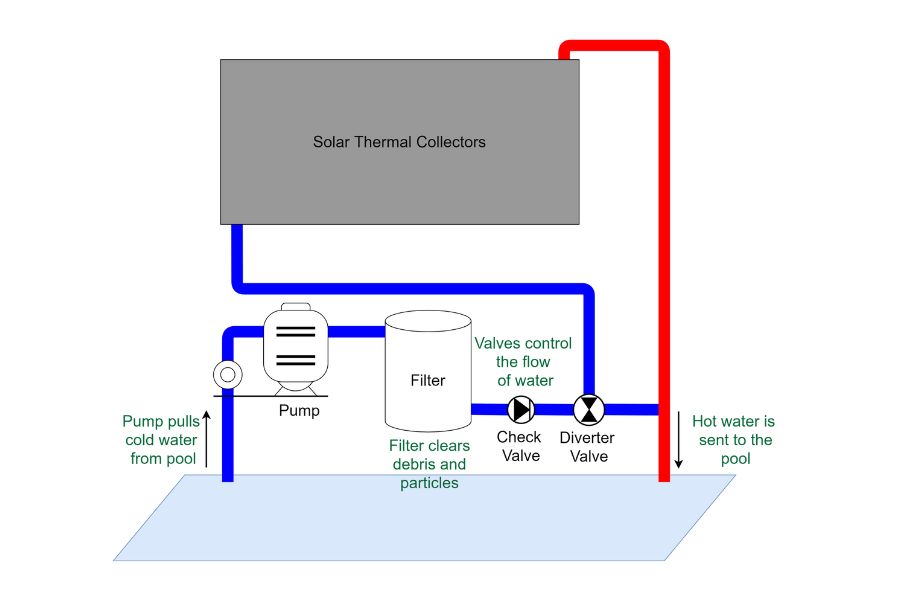
This is the simplest approach but requires manually opening and closing valves.
You install a diverter valve on the return line after the filter and heater (if you have one). When you want to run the solar loop, you turn the valve to direct water through the solar panels instead of directly back to the pool.
The manual valve lets you choose whether to run filtration only, solar heating only, or both at once. But someone has to remember to change the valve position seasonally or daily.
Motorized Valve
An upgraded option is using an automated valve controlled by the solar controller. This allows hands-free operation.
Electronic sensors detect when solar heat is available and automatically open the electric valve to divert water through the solar collector when needed.
Solar Booster Pump

One final option is to install a separate pump parallel to the main pump. This allows independent flow rates through each loop.
You may need a solar booster in cases where the existing pump cannot provide enough flow and pressure for filtration and solar heating.
Running both pumps together ensures optimal flow through the solar collectors and filter simultaneously. It works great but means even higher equipment costs.
Option 2: Completely Separate Loop
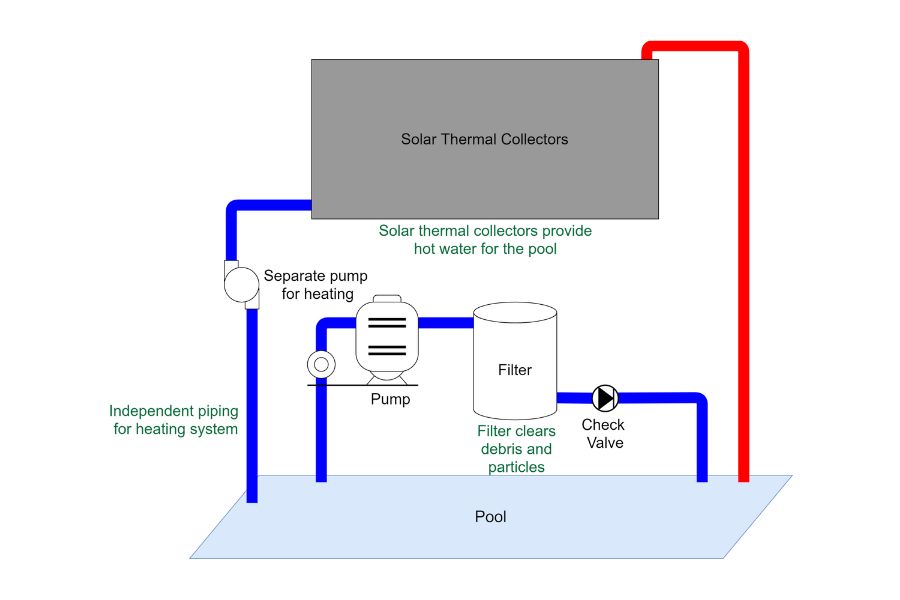
If you want complete separation between filtration and solar heating, use a 100% isolated plumbing loop.
This involves installing dedicated solar supply and return lines, usually when building a new pool. It keeps the solar loop completely independent from the filtration system.
Benefits include:
- Zero impact on filtration flow and pressure when heating
- Can situate equipment in different equipment pads or locations
- Maximizes energy efficiency of the solar pump
The downside is added complexity and costs for extra plumbing and excavation.
If undertaking major renovations or building a pool from scratch, 100% separate filtration and solar loops are ideal. However, the tapped method works very well for most existing pools.
What Are the Benefits of a Dedicated Solar Pump?
Adding a separate pump exclusively for your solar heating loop provides several advantages:
Optimized Flow Rate
Solar collectors require a lower flow rate, usually around 10 GPM per 100 sq ft collector area. Running too much volume damages the collectors over time.
A small, specialized solar pump can precisely dial the ideal flow rate.
Maximized Efficiency
The lower flow rate lets the water absorb more heat as it passes through the solar panels. This maximizes efficiency compared to blasting high volumes of water through quickly.
Extended Equipment Life
The lower-capacity solar pump reduces strain on the system compared to your 3HP filtration pump. Lower flow and pressure lead to less wear and tear, extending the life of all equipment.
Energy Savings
A tiny 500-watt solar pump running for 8 hours uses far less energy (4 kWh) than a large 2HP filter pump running that long just to drive the solar loop. This provides savings on electricity.
Flexible Operation
You can run the solar loop with separate pumps without turning on the whole filtration system. This allows you to heat precisely when the sun is out.
Simple Retrofitting
Installing a solar pump alongside your current equipment is much easier than replumbing your system for optimal flow and pressure.
As you can see, the pros of adding a dedicated solar pump are compelling for both efficiency and equipment longevity.
What Are the Cons of Separate Pumps?
While the benefits typically outweigh the downsides, here are a few potential drawbacks to consider:
- Added Upfront Cost – A solar pump and associated plumbing and valves represent an added expense.
- More Complex System – Two pumps and associated plumbing are slightly more complex than a single pump setup.
- Additional Maintenance – You must inspect and maintain one more piece of equipment.
- Pump Sound – Some people don’t like hearing two pumps running.
For most folks seeking to optimize their solar heating system, the long-term benefits of a dedicated pump greatly outweigh these minor drawbacks. Solar pumps usually cost just $200-$500 and run silently.
How to Choose the Right Solar Pump Size

Once you know the plumbing scheme, properly sizing the solar pump is key to maximizing collector efficiency.
The optimal flow rate through most solar collectors is around 10 GPM per 100 sq ft collector surface area.
So, for example:
- 200 sq ft collector = 20 GPM pump
- 400 sq ft collector = 40 GPM pump
Refer to the manufacturer’s specs for your particular solar panels to verify the recommended flow rate.
Factors like pump power source (AC or solar), pipe length and routing, and total dynamic head also impact pump selection. Consulting a solar pool heating contractor is wise to get this right.
Is a Solar Pump Worth the Investment?
While the upfront costs are moderately higher, a dedicated solar pump usually pays for itself rapidly through energy savings and equipment longevity.
Assuming your main filtration pump runs 8 hours daily, converting to a small solar pump running only when needed could save thousands of kilowatt hours per year.
Well-designed solar heating systems can keep pools comfortably warm for pennies per day. And reducing strain on your main pump and filter can add years to their functional life.
Carefully weigh the benefits vs. costs outlined above. Adding a specialized solar heating pump is a smart investment for most pool owners.








